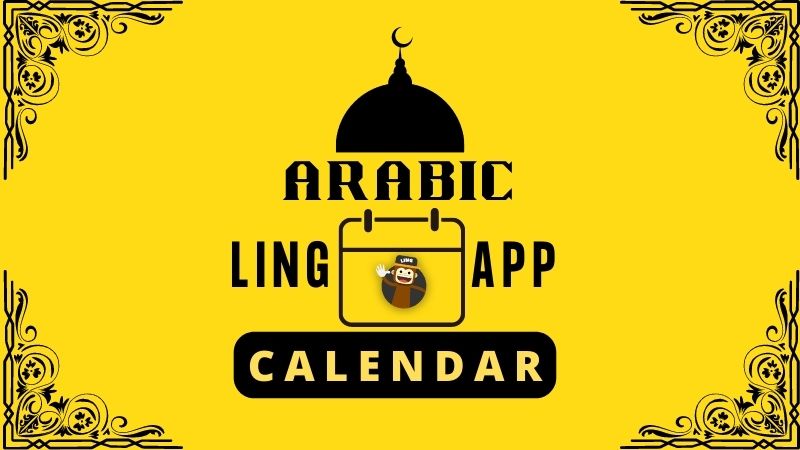Almost all countries use the Gregorian calendar for date-related purposes. Still, the Islamic/Arab countries also have a calendar of their own, which they follow along with the Gregorian calendar. The Islamic or Arabic calendar, which is also known as the Muslim calendar, lunar or Hijri calendar, or Islamic Hijri calendar, is followed by all the Muslims of the world.
The Arabic calendar determines the dates of many important religious events and observances by the Muslim community. There are many customs of the Arabic calendar. After reading this blog post, you will know everything a person should know about a Hijri calendar. Let’s get to know more about this below!
What Is The Tabular Islamic Schedule?
The tabular Islamic schedule is a standard-based variety of the Islamic agenda, and wherein months are worked out by number juggling rules instead of by perception or cosmic computation. It has a thirty-year cycle with eleven jump long periods or leap years of 355 days and 19 years of 354 days. In the long haul, it is exact to one day in around 2,500 Solar years.
Significance Of Moon Phases In Arabic Calendar
There are mainly two types of calendars in the Muslim world. The one whose time is tied to the Sun’s placement is called the Solar year, and the one whose time is connected to the Moon’s position is called the Lunar year.
The Hijri calendar depends on the moon’s phases, so it is a Lunar year. Every Islamic month goes on for a complete lunation, which is the period starting with one new Moon and then onto the next. This Moon cycle covers every one of the periods of the Moon.
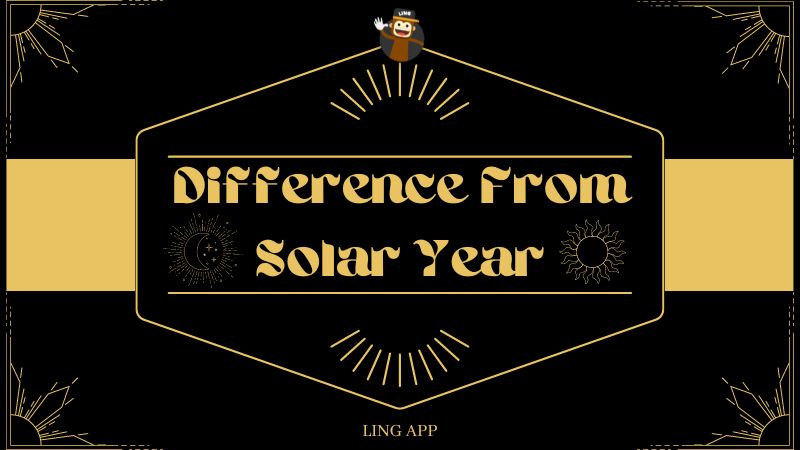
Difference Of Islamic Calendar From Solar Year
The Islamic calendar is unlike all the other schedule frameworks that utilize leap days to synchronize the schedule with the Solar year. The Islamic schedule is disconnected from galactic seasons, set apart by the equinoxes and solstices. An Islamic year always falls around eleven days short of the Solar year.
The Year 1
Some people usually think about how and when this new calendar started. Well, I have the perfect answer to this question.
This Islamic calendar started when the Holy Prophet migrated from Makkah to Medina, year one of this Hijri calendar. The name is the Hijri calendar because in Arabic, leaving one place and moving to another is called “hijrah,” hence the name Hijri calendar. Moreover, the first year was named “the year of permission” because, in the old times, it was customary to name each year. So, because of these first ten years, we’re named:
- 1 AH was named The year of permission.
- 2 AH was named The year of the order to fight.
- 3 AH was named The year of trial.
- 4 AH was named The year of congratulation on marriage.
- 5 AH was named The year of the earthquake.
- 6 AH was named The year of enquiring.
- 7 AH was named The year of gaining victory.
- 8 AH was named The year of equality.
- 9 AH was named The year of exemption.
- 10 AH was named The year of farewell.
Structure Of Arabic Calendar
Like many other calendars, the Islamic or Arabic calendar has twelve months, each consisting of almost twenty-nine or thirty days. Easy right? So is learning the Arabic language: difficult but easy too.
If a thin new crescent is seen after sunset or after the namaz (prayer) of Maghrib on the twenty-ninth day, then it means that a new month has started. Otherwise, the next day would be the thirtieth of the same month.
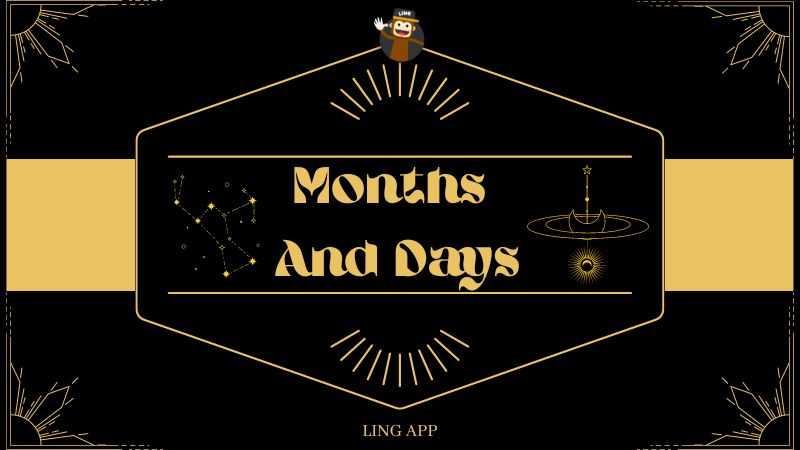
Months And Days Of The Arabic Calendar
The Islamic Hijri calendar consists of the following months.
Muharram – محرم
Muharram is the starting and the first month of the Islamic Calendar and is among the four sacred months of the Islamic calendar. It is a month of sorrow because of some religious events and has 29/30 days.
The Grand Mosque seizure incident took place on the 1st of Muharram. The 10th of Muharram is remembered as the day of Ashura and is an Islamic holiday. Distributing Arabic food and water to all is a common custom of this month.
Saffar – صَفَر
Saffar is the second month in the Islamic calendar and means “empty, vacant.” This is called Saffar because people used to forge for food this month, and the whole town got empty. It consists of 29-30 days.
It is a common myth that many accidents occur in the month of Saffar, so one should recite more duas (prayers/recitations) when leaving the house. Salahuddin Ayyubi died on 27 Saffar. The Holy Prophet fell deathly ill on the 28th of Saffar.
Rabi Al Awwal – رَبِيع ٱلْأَوَّل
Rabi al Awwal is the third Islamic month.
Rabi al Awwal was a significant month before and after Islam, as it was the first month of spring, and people were happy because of the excess food resources. Moreover, Rabi al Awwal was the month the Holy Prophet was born, so Arabs and Muslims generally have deep sensations attached to this month.
Rabi Al Thani – رَبِيع ٱلثَّانِي
Rabi al Thani is the fourth Islamic month in the Hijri calendar, and this month is also called Rabi al Akhir. Rabi al Thani has many historical events, including Imam Hasan al-Askari’s birth on the 8th of Rabi al Thani.
Hazrat Abdul Qadir Jilani, also known as the Saint of the saints, also died in the month of Rabi al Thani. The date of his death is not sure, but it is believed that it was either the eleventh or thirteenth of Rabi al Thani.
Jamada Al Awwal – جُمَادَىٰ ٱلْأَوَّل
Jamada al Awwal is the first Jamada and is sometimes written as Jamada 1. It is the 5th Islamic month, meaning dry and cold in English. This month was among the hardest and coldest at that time in Arab states.
Jamada al Awwal has many important religious events. The Final Prophet’s daughter Fatima al Zahra passed away at the age of 23 years on the tenth of Jamada al Awwal. On the 5th and 15th of Jamada al Awwal, Zain ul Abideen (son of Imam Hussain) and Lady Zainab Binte Ali were born, respectively.
Jumada Al Thani – جُمَادَىٰ ٱلثَّانِي
Jumada al Thani is the second and the final Jumada and is also known as Jumada al Akhir. Jumada al Thani is the 6th month of the Islamic calendar. Like the other Jamada, this month is also frigid, and it is said that it might freeze the water in open-air conditions.
Among the significant events that took place in Jumada al Thani are the death of Companian Abu Bakar on the 22nd, the death of Haroon al Rasheed on the 3rd, and the birth of Lady Fatima on the 20th, Jumada al Thani.
Rajab – رجب
Rajab happens to be the 7th month in the Islamic calendar. Rajab is derived from the word Rajaba – رجابہ which means “to respect.” Rajab is among the four most sacred months of the Islamic calendar, and fighting in the holy months is strictly prohibited. The blessed month of Rajab has many significant dates to remember.
Islam’s caliph Ali’s birth occurred on the thirteenth Rajab. He was also a cousin and son-in-law of the Holy Prophet Muhammad. Despite being forbidden to fight, the battle of Tabook was also fought this month. The event of Miraj on which the sacred prophet met Allah (The God in Islam) happened on 27th Rajab.
Other than these, Owais Qarni and Abu Talib, the uncle of Prophet Muhammad and father of Ali, passed away on the 3rd and 26th of Rajab, respectively.
Shaaban – شَعْبَان
Shaaban is the 8th month in the Islamic Hijri calendar. The meaning of Shaaban is “separation.” This month was named Shaaban because the Arabs used to forge for water in Shaaban, and every individual would go in a separate direction hence the name Shaaban.
Shaaban was among the months in which the Holy Prophet used to fast a lot, except Ramadan. The most important event of Shaaban is the moon sightings on the 29th and 30th of it, the upcoming month of Ramzan.
Ramazan – رمضان
Ramazan is one of the most critical and ninth Islamic months. Ramazan is derived from Ramida, which means “intensely hot.” Every Arab must fast during the month of Ramazan as it is the third pillar of Islam.
Food, water, and wrong and sinful behavior are avoided during the month of Ramazan. The significance of the month of Ramazan is countless.
The revelation of the Quran (Holy book for Muslims) was completed in the month of Ramazan. The Battle of Badr was fought on the seventeenth Ramazan, in which Muslims got their victory. Lady Khadeeja, the first wife of prophet Muhammad, died on the tenth Ramazan. The conquest of Makkah took place on 20th Ramazan.
Tip: You should know the useful Arabic greetings as you will need them while wishing an Arab a happy Ramadan.
Shawwal – شَوَّال
Shawwal is famous for moon sightings in the Arabic months and is the tenth month of the Islamic Hijri calendar. The word Shawwal means to carry.
The month was named Shawwal because the female camels were most likely to get pregnant at this time. The most important event of Shawwal is Eid ul Fitr which is celebrated as a reward for fasting for a whole month.
Dhu Al Qadah – ذُو ٱلْقَعْدَة
Dhu al Qadah is the eleventh and the second last month of the Islamic Hijri calendar. Dhu al Qadah is also among the four sacred months in the Islamic calendar, and battles, fights, and quarrels are strictly prohibited in this month.
This month is also called the “Master of Truces.” The truce and treaty of Hudaybiya took place on the 1st of Dhu al Qadah. Prophet Ibrahim and Prophet Eesa (Jesus) were also born in Dhu al Qadah.
Dhu Al Hijjah – ذُو ٱلْحِجَّة
Dhu al Hijjahh is the Islamic calendar’s last and twelfth month. Dhu al Hijjah means “the month of pilgrimage”.
It is the most sacred month. The pilgrimage is performed this month, and Eid al Adha is celebrated along with the sacrifices. Dhu al Hijjah has too much importance in the life of Muslims worldwide. The 9th of Dhu al Hijjah is the day of Arafa. On the tenth of it is Eid al Adha and on the 18th dhu al Hijjah it is Eid al Ghadeer. 1st Dhu al Hijjah was the date when Hazrat Ali and Hazrat Fatima got married to each other.
Arabic Calendar
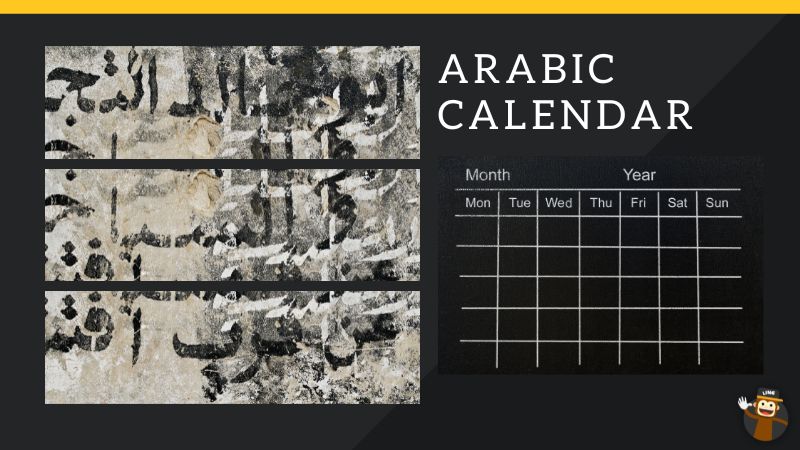
The following calendar data is the Islamic calendar 2022 (Lunar year).
January
According to the Gregorian date, 1 January 2022 matches the date 28 Jamada al Awwal according to the Hijri calendar 1443. And as the month ended on 31 January 2022, the Islamic date was 28 Jumada al Thani 1443.
February
The month of February started with the Islamic date 29th of Jumada al Thani and ended on 28 February 2022 with the Islamic date 27 Rajab 1443.
March
The third month of March started with the 28th of Rajab and ended on 31 March 2022 with the Islamic date 28th of Shaaban 1443.
April
The month of April 2022 started with 29th Shaaban and ended on 30 April 2022 with the Islamic date 29th Ramazan 1443.
May
May 2022 started with 30th Ramazan and ended on 31 May with the Islamic date 1st Dhu al Qadah 1443.
June
June 2022 started with 2nd Dhu al Qadah and ended on 30 June and the Islamic date at that time was 1st Dhu al Hijjah 1443.
July
The month of July 2022 started with the second Dhu al Hijjah 1433, and it ended on 31 July with the 2nd Muharram 1444. A new Islamic year had started.
August
August 2022 started with the 3rd of Muharram 1444 and ended with the Islamic date 4th of Saffar 1444.
September
September 2022 started with the 5th of Saffar and will end on 30 September 2022 with the Islamic date fourth Rabi al Awwal 1444.
October
October 2022 will start with the 5th of Rabi al Awwal 1444 and will probably end on 30 October 2022 with the date 5 Rabi al Thani 1444.
November
November 2022 will start with the date 6 Rabi al Thani and end on the 30th with the Islamic date 6 Jamada al Awwal.
December
December 2022 will start with the date 7 Jamada al Awwal and will most likely end with the Islamic date 7 Jumada al Thani.
Key Dates Of 2022 Arabic Calendar
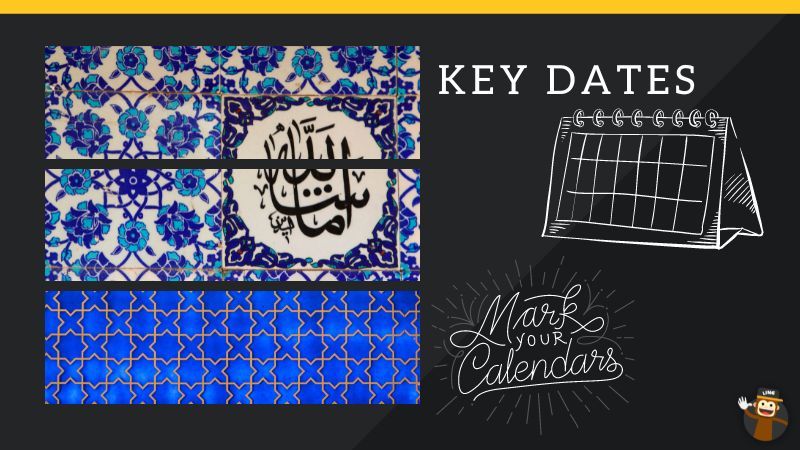
Some of the dates of religious events in the year 2022 are mentioned below. The data is based on previous religious events, observances, and moon sightings.
- 28 February 2022 – Al Isra wal Mi’raj.
- 2 April 2022 – Ramazan begins.
- 2 May 2022 – Eid ul Fitr.
- 30 June 2022 – 1st Dhu al Hijjah.
- 8 July 2022 – Day of Arafah.
- 9 July 2022 – Eid al Adha.
- 30 July 2022 – Start of the Islamic year 1444.
- 8 August 2022 – Ashura day.
- 8 October 2022 – 12 Rabi al Awwal.
Uses Of Arabic Calendar
The Islamic/Arabic calendar is currently utilized for religious purposes and accurate dating of public occasions and reports in Arab/Muslim nations. Because of its tendency as a simple lunar schedule, it can not be utilized for horticultural purposes, and generally, Islamic people groups have involved different programs for this reason.
Wrapping Up

That’s it for this blog post. Since you have made it this far, I’d assume that you’re either an Arabic language learner or extremely into learning about the Arabic culture. In either case, you should check out the Ling App, which is the best app for learning new languages.
The Arabic language is a real embodiment and manifestation of a centuries-old heritage. Nothing except courtesy and consideration can be seen, from the sentence form to the way people speak to one another. Because of this, learning Arabic is a great investment if you value Arabic culture.
There are several methods for learning Arabic. Such blog articles are available for free reading. The articles are available for you to start with, like Arabic Sentence Structure, Arabic Verbs, and the Arabic Alphabet.
However, now that you’ve come this far, you may also utilize Ling App. Ling App is a great option if you want to increase your vocabulary and proficiency in Arabic because it is user-friendly and handy. Utilize Ling App to have a fruitful and enjoyable language-learning experience. Download the Ling App from Google Playstore or App Store.
Bid adieu to competitive deadlines, books, and classes. Start learning Arabic right away!
